Jaguars
 Most people associate the jaguar (scientific name Felis
onca) with Central and South America. Indeed, its historic
range includes much of Central and South America as well as parts of Mexico and
portions of the extreme southern United States. During the last Ice Age, however,
this large cat was also found in much of the southern half of the United States.
Most people associate the jaguar (scientific name Felis
onca) with Central and South America. Indeed, its historic
range includes much of Central and South America as well as parts of Mexico and
portions of the extreme southern United States. During the last Ice Age, however,
this large cat was also found in much of the southern half of the United States.
The jaguar is the largest member of the cat family living today in the
western hemisphere. Modern jaguars range in weight from 36 to
158 kg (80 to 350 lbs). During the last Ice Age, the jaguars found
in the United States were even larger than this. Some may have
weighed up to 190 kg (420 lbs).
The jaguar skull to the right is in the collection of the Illinois State Museum.

During the last Ice Age jaguars were found in several states in
the southern portion of the midwestern U.S. This map shows some of the sites at which the jaguar has been found
in the midwestern United States. In this area its remains have been
found mainly in caves.
The sites on this map are all relatively well-dated and
well-studied. These sites contain jaguar remains that are between
40,000 and 11,500 years old.
One of the most interesting fossil jaguar finds is from Missouri.
About 160 km (100 mi.) south of St. Louis, in Perry County, Missouri, one
cave contains a jaguar bone and several hundred probable jaguar footprints.
Read more about this cave site in
Missouri.
Jaguar tracks from a cave in Missouri
 These footprints
are preserved on the mud in a passage in the cave. Although it is difficult
or impossible to identify the
track-maker with certainty, these tracks are thought to have been
made by a jaguar. Photograph taken by Mona Colburn
These footprints
are preserved on the mud in a passage in the cave. Although it is difficult
or impossible to identify the
track-maker with certainty, these tracks are thought to have been
made by a jaguar. Photograph taken by Mona Colburn
The cave passage in which the tracks occur is relatively large;
it is large enough for people to walk upright for the entire length
that tracks occur. Except for the dark, a jaguar would have no
problem navigating the passage.
The footprints occur in a trackway that can be traced for
over a 1.6 km (1 mile) in the cave.

This map shows a section of the trackway approximately 6 m (20 ft)
long and 3 m (10 feet) wide.
Unfortunately there is no way to date these tracks. We know that
they must be older than 11,500 years ago, because jaguars have not
been in Missouri since then. However, the tracks might be 13,000
years old, 25,000 years old, or much older.
In addition to the tracks, the cave also contained a jaw bone
from a jaguar. This adds support to the idea that the tracks were
made by a jaguar, rather than a mountain lion or saber-tooth
cat.
For more information on the site, see Oesch
(1969).
 Most people associate the jaguar (scientific name Felis
onca) with Central and South America. Indeed, its historic
range includes much of Central and South America as well as parts of Mexico and
portions of the extreme southern United States. During the last Ice Age, however,
this large cat was also found in much of the southern half of the United States.
Most people associate the jaguar (scientific name Felis
onca) with Central and South America. Indeed, its historic
range includes much of Central and South America as well as parts of Mexico and
portions of the extreme southern United States. During the last Ice Age, however,
this large cat was also found in much of the southern half of the United States. 
 These footprints
are preserved on the mud in a passage in the cave. Although it is difficult
or impossible to identify the
track-maker with certainty, these tracks are thought to have been
made by a jaguar. Photograph taken by Mona Colburn
These footprints
are preserved on the mud in a passage in the cave. Although it is difficult
or impossible to identify the
track-maker with certainty, these tracks are thought to have been
made by a jaguar. Photograph taken by Mona Colburn